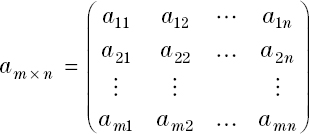APPENDIX 3
Matrix Solution to Linear Equations and Markov Chains
DIRECT SOLUTION AND CONVERGENCE METHOD
Before computer programs offered ready solutions, problems such as Markov chains were solved in a direct manner, by algebraically manipulating the equations. This direct solution requires an understanding of simple matrix arithmetic, and very careful attention to calculating the numbers correctly. The convergence method is now easier, although it requires many more calculations. Without the computer, we would never even consider using this approach—with a computer, it is the best choice.
GENERAL MATRIX FORM
A matrix is a rectangular arrangement of elements into rows and columns. A matrix A is said to be m × n (pronounced “m by n”) if there are m rows and n columns in A.

Certain properties of a matrix make it a valuable tool for solving simultaneous linear equations. These elementary matrix operations, called transformations, allow you to alter the rows (which will represent equations) without changing the solution. There are three basic row operations:
- Multiplication or division of all elements of the row by any number.
- Interchanging of any two rows (and consequently of all rows).
- The addition or subtraction of the elements of one row with the corresponding elements of another.
To relate the matrix to simultaneous linear equations, consider a three-equation example, where ...
Get New Trading Systems and Methods, Fourth Edition now with the O’Reilly learning platform.
O’Reilly members experience books, live events, courses curated by job role, and more from O’Reilly and nearly 200 top publishers.

